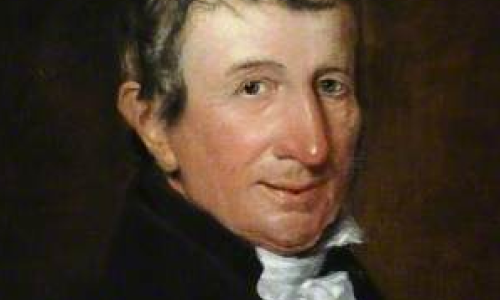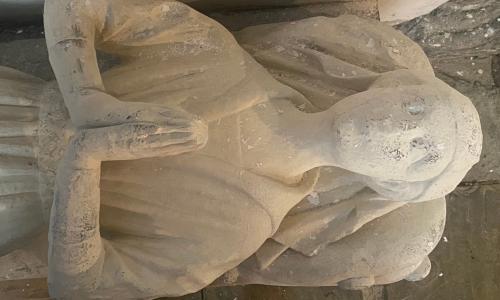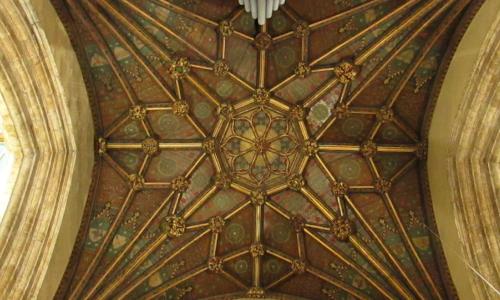The Capital Virgins - who are they and why are they there?
On either side of the arch between the North Nave Aisle and the North Transept are two young ladies in early 15C fashionable dress. They sit at the base of the capitals, part of the columns which form the arches – but they are also 'Capital Virgins' in mediæval religious legend.
The lady on the left (North side) wears a crown or garland with floral or rosette motifs. In her left hand she holds a palm branch, in her right what appears to be a small model castle or tower-house.
The lady on the right (South side) wears a royal crown. In her right hand she holds a sword or long dagger, the hilt balanced against her shoulder. Her left hand is broken off, but appears to have held some kind of straight-sided object.
St Barbara
The lady with the tower is easy to identify from her attributes: the palm-branch of the victorious martyr, and the tower. She is Saint Barbara, a virgin martyr traditionally associated with Heliopolis in Phœnicia (modern Baalbek in Lebanon) and venerated in Eastern and Western churches alike.
There is no historical evidence for Barbara’s existence in the martyrologies of the early Church, but her legend was circulating by 7C CE. She was said to be the daughter of a pagan noble, Dioscuros, in the reign of Maximian. Her father imprisoned her in a tower. During his absence, she is said to have insisted that the bath-house he had ordered to be constructed should have three windows to represent the Trinity. When her father returned, he found out through this that she was a Christian. He tried to kill her himself, and then handed her over for trial. She suffered a wide range of different tortures, only to be miraculously healed each time. Her father then took her away to behead her, but after doing this, he was struck by lightning and killed. As a result, she became a patron saint of anything involving explosives – artillery, miners and engineers – and of builders (because of the tower). She is popular in mining areas and with navies (because of use of cannon). She was removed from the General Roman Calendar in 1969, though not from the list of saints, because of lack of historical evidence of her real existence.
St Catherine
The second lady is harder to identify because of the loss of the object in her left hand. Several martyrs were killed with swords, so the sword in her right hand is not a conclusive attribute. However, she wears a crown and the broken-off object seems to have had a straight edge, so may have been a book. Her pairing with Barbara also supports the likelihood that she is another virgin martyr, Saint Catherine of Alexandria.
Catherine, like Barbara, is of doubtful historicity. Her legend overlaps with that of Dorothea of Alexandria, possibly the same character under another name, and also may be in part a Christianisation of the NeoPlatonist scholar Hypatia, who was actually murdered by a Christian mob. She was said to be a well-educated noblewoman of Alexandria who disputed with pagan philosophers and was executed during the reign of Maxentius. Again, she suffered various tortures of which she was healed, and was threatened with use of a spiked wheel, miraculously destroyed. Eventually she was beheaded with a sword, having allegedly converted the Empress, who was also tortured and executed on her husband’s orders. She was a patron of philosophers and scholars, but also of wheelwrights, potters and anyone working with wheels.
Her story is depicted in 15C murals in Pickering Parish Church, almost like a graphic novel.
How did they become known?
Barbara and Catherine became important figures in mediæval devotion, although it is likely that their stories originated as religious fiction – Byzantine moral fables, embellished with folklore and borrowings from lives of historically attested saints. In the Orthodox Church, they were among the Great Martyrs and popular as subjects of icons.
In the West, their stories attained their established form and popularity through the Legenda Aurea – The Golden Legend – a compendium of saints’ lives compiled c. 1260 by Giacomo di Fazio di Varazze (Jacobus de Voragine), a Dominican friar, later Archbishop of Genoa. This was one of the most widely read books in mediæval Europe. It was written in simple Latin, and translated into vernacular languages. Over a thousand manuscripts of it have survived, and it was also a popular work for early printers: before 1501, more editions of it were published than of the Bible. William Caxton published an English edition in 1483. The Golden Legend shows how formulaic many of the legendary saints’ lives had become by the mid 13C. They are ‘Perils of Pauline’-type dramas, with interchangeable plot motifs and repeated tortures. Wounds were miraculously healed so the martyr could be made to suffer again and again, like a cartoon character, until finally killed, usually by beheading. In the young women’s stories, violence was often sexualised, especially torture of the breasts: this happens to Barbara, Catherine, and Catherine’s friend the Empress, among others. Paintings of their martyrdoms took a disturbing interest in mixing nudity and injuries.
Barbara and Catherine were among the Fourteen Holy Helpers, a cult that developed in the Rhineland during the Black Death, and spread more widely. The other twelve were Agathius, Blaise, Christopher, Cyriacus, Denis, Erasmus, Eustace, George, Giles, Margaret of Antioch, Pantaleimon and Vitus. The three virgin martyrs were at the head of the group.
They were also two of the four Capital or Excellent Virgins (the others being Margaret of Antioch and either Dorothea of Cæsarea or Ursula of Köln) who were depicted as heavenly ladies-in-waiting to the Virgin Mary. As Queen of Heaven, Mary was expected to live like an earthly queen, so needed suitable ladies to attend her.
In the Minster
By the 15C, both Barbara and Catherine had their own altars in Holy Trinity. These would have had a painting or sculpture of them as their focal point. In the Gallery below are examples of altarpieces from this time-period. There was also a Guild of St Catherine in Hull. Catherine's feast day is on 25 November, Barbara's on 4 December. These would have been celebrated with masses at their altars.
The placing of our carved figures on either side of the arch between the Nave and the North Transept suggests another aspect of their role. Barbara and Catherine, like Saint Christopher, were regarded as offering protection and intercession in case of sudden and unexpected death. Barbara in particular was supposed to protect her devotees from dying unshriven – without confession or extreme unction – in violent accidents at work. Images of Saint Christopher were usually found near the West door of a church, to protect people leaving the building: it is possible one was painted on the wall between the windows towards the West end of the South Nave Aisle. Barbara and Catherine have been positioned to protect people leaving by the door in the North Transept. They would be watching over them.




